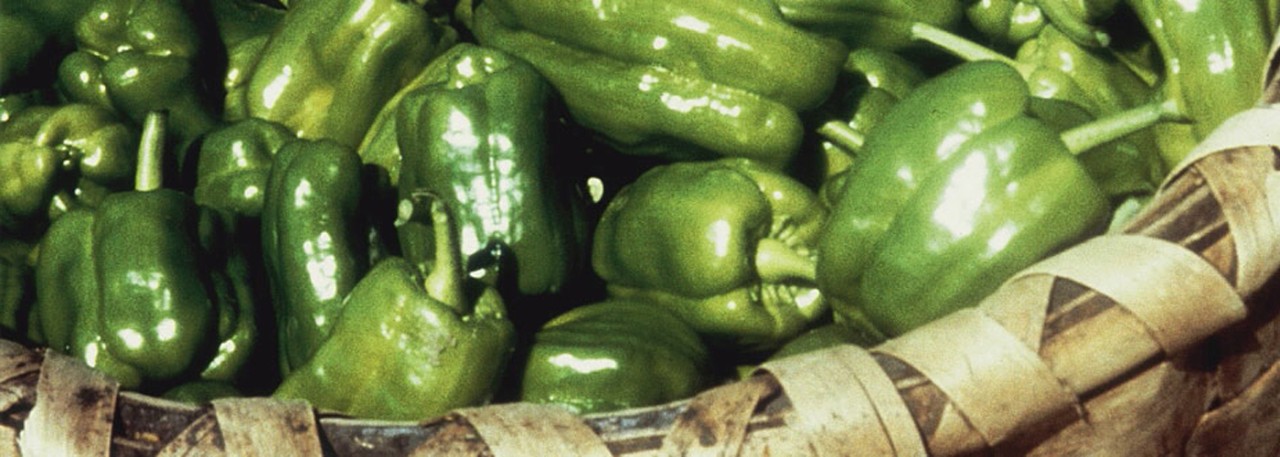.png.transform/rendition-xs/image_image%20(1).png)
Pemento da Arnoia PGI
This fruit belongs to the eco-type of the species Capsicum annuun, L, traditionally grown in the production area, intended for human consumption and sold fresh.
Tasting notes
The skin is smooth, shiny and light green in color. The flesh has a thickness of between 2.6 and 7.7 mm / 0.07 and 0.1 ins, an intense aroma and sweet flavor, and is very mild.
Other notes
The fruit is picked when it is not yet fully ripe. The peppers are conical in shape, with a trapezoidal longitudinal section, 3 or 4 segments, 4 membranes and a variable number of quite clear longitudinal partitions. The tip can be either split or rounded and the area around the stalk is lobed. They weigh between 50 and 90 g each, their length varies from 7.5 and 15 cm / 2.9 to 5.9 ins and at they are between 5 and 7 cm / 1.9 and 2.7 in wide.
Production / Processing method
The ripe (red) fruit is dried and the seeds extracted. The seedbeds are prepared in January. Seeds are covered with tunnels made of plastic sheets. The seedlings are planted out in the growing plots from mid-March onwards, with a growing area of about 50 cm x 40 cm / 19.6 in x 15.7 in around each plant. The maximum permitted yield is 40,000 kg / 88,184.8 lb per hectare. Watering is essential for this crop to grow properly, and is done at soil level, as any other way would damage the flower and the fruit.
Organic fertilization is concentrated in a single dose at the time of planting, using cow or chicken dung. The fight against possible infestation and disease is aimed mainly at applying cultivation methods such as seed disinfection and seedbed treatment. Picking is done by hand, before the fruit is fully ripe and at a time when farmers judge that conditions are ideal for selling. Picking is carried out in as many waves as may be necessary, using the materials (tools, boxes, containers, etc.) and human means required to prevent the product from deteriorating.
The peppers are transported in rigid containers, to avoid squashing them. Unloading is done in such a way that any damaging effects from the fruit falling are minimized. Storage areas must be properly ventilated.
The peppers are sold in string bags weighing between 500 g / 17.6 oz and 1 kg/ 2.2 lb made from materials authorized by current food legislation. Other presentation formats may be used if they are proved not to have a detrimental effect on product quality.
Geography / Relief and climate
The nature of the soil in this area makes it an ideal place for growing peppers, as it is mainly sandy-loam rich in organic matter, enabling good drainage and aeration, meaning that the plants can be watered frequently - the plants are drought-sensitive so the soil must always be kept moist - but without allowing the ground to become waterlogged, as this can cause the fruit to asphyxiate or the tips to rot.
The climate in this part of the top valley of the river Arnoia is particularly suited to the Arnoia ecotype and accounts for both the longstanding tradition of growing this pepper here and the special features of the fruit. The "Pemento da Arnoia" pepper, like the majority of sweet-flavored peppers, is a very demanding plant, both in terms of light, which is abundant in this south-west facing production area, and in terms of temperature, an environmental factor that has an appreciable effect on some aspects of product composition, such as its high fat content.
Germination requires a minimum temperature of 13ºC / 55.4ºF, which is typical here from the third week in April onwards. Ideal temperatures for development vary between 20 and 25ºC / 68 and 77ºF (daytime) and between 16 and 18ºC / 60.8 and 64.4ºF (night-time), which are guaranteed here during the July to September period.
Regulatory Council
Instituto Galego da Calidade Alimentaria (INGACAL)
Pazo de Quián - Sergude
15881 Boqueixon (A Coruña)
Galicia
Tel: (+34) 981 997 276
ingacal@xunta.es
www.medioruralemar.xunta.es/
Sources:
The tip can be either split or rounded and the area around the stalk is lobed.


- /content/dam/en/icex-foodswines/images/products/fruits---vegetables/pemento-da-arnoia-pgi/Pemento%20da%20Arnoia%20PGI%20carr1.jpg
- /content/dam/en/icex-foodswines/images/products/fruits---vegetables/pemento-da-arnoia-pgi/Pemento%20da%20Arnoia%20PGI%20carr2.jpg

Boqueixón (Galicia)
